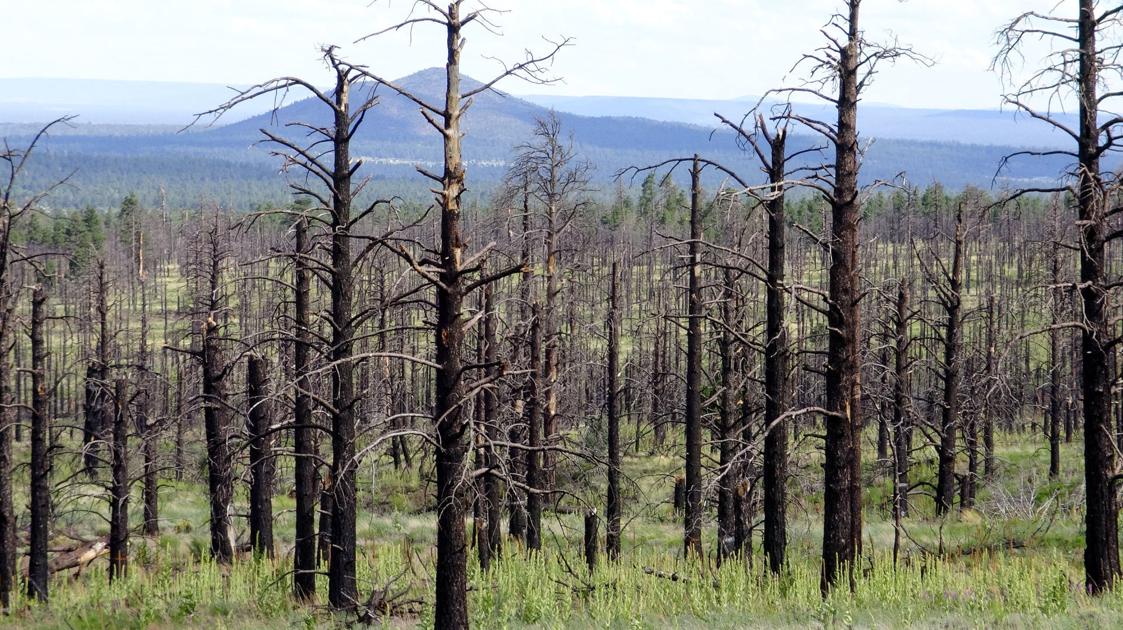
The combination of recurrent drought and wildfires in the West in the past 30 years has made it far more difficult for forests to recover — even during a string of normal or wet years, according to a growing number of studies.
As a result, areas burned by big fires like the Wallow, Rodeo-Chediski and even the recent Highline Fire may never return to former conditions, say researchers.
As Rim Country savors a couple of wet days in one of the driest winters on record, the evidence continues to mount that a warming climate, a century of mismanagement and a new era of megafires may produce long-lasting changes. Perched on the boundary between pinyon-juniper and ponderosa pine forests, Rim Country may undergo a wrenching transformation as a result of unremitting fire and drought — coupled with higher average temperatures.
Three recent major studies have focused on the slow or non-existent recovery from wildfires and drought in forests. The findings generally underscore the need for more use of thinning, prescribed fire and low-intensity managed fire to minimize the effects of megafires. They also suggest towns like Payson or Show Low will face a constant, long-term threat from wildfire. However, most northern Arizona forested cities and counties have neither wildfire-adapted fire-adapted building codes or Firewise brush thinning programs.
Recent studies include:
Drought increases recovery time
The time it takes forests to recover from drought years increased significantly in the late 20th century as average temperatures continue a slow, steady rise, according to a study by researchers from Northern Arizona University and Carnegie Institution for Science published in the peer-reviewed journal Nature.
The team actually measured the ability of leaves to turn sunlight into energy during and after droughts.
They found that the effect of dry years accumulates, even if a wet year interrupts the drought. Rim Country has gone in and out of drought conditions for the past 20 years, with only the occasional year of normal rainfall. Some studies show we’re in the midst of the most severe drought period in nearly 1,000 years.
The researchers found that repeated dry years sapped the ability of leaves to produce energy for the tree. This eventually reaches a biological “tipping point” from which the tree can’t recover, even with normal rainfall. Unusually, hot or cold conditions increased the effect, making it harder for the trees to survive the effects of the drought.
Given a projected rise in average temperatures and an increase in the length and severity of drought, the researchers predicted a “chronic state of incomplete drought recovery” for the remainder of the 21st century.
Forests can’t recover
A stunning one-third of forests in the West have made virtually no recovery from wildfires in the past 23 years, according to a massive study of 1,500 sites in five western states by researchers from Colorado State University and eight other universities and research groups. They published their findings in the peer-reviewed scientific journal Ecology Letters.
The researchers measured the growth of 63,000 seedlings after 52 fires that burned in the past 30 years in Colorado, Wyoming, Washington, Idaho and Montana. They wanted to determine whether rising average temperatures and increased drought would affect growth of seedlings.
They found seedlings either didn’t grow or grew far more slowly than in past decades. In a full one-third of the 1,500 study areas — no seedlings sprouted or survived at all. The warmest, driest sites were most likely to see no seedling growth.
The researchers concluded the findings show climate change has already had a significant impact on forest resilience and recovery. The researchers called the changes “dramatic” in just the past 23 years.
The researchers said the findings suggest it might not make sense to replant the same, dominant tree species after a major fire — since they’re unlikely to grow in dry, warm conditions. That could mean planting pinyon pine or juniper to replace ponderosa pine, depending on local conditions.
Moreover, the findings suggest the Forest Service and other agencies should foster far more low-intensity, managed fires. The forest is much more likely to survive and return after such low-intensity fires, since they usually don’t kill the big trees and reduce tree competition for the available water. Most important, they create a “patchy,” more natural forest. The trees in the unburned patches spread seeds into the burned areas, enabling the forest to recover far more quickly.
Contact the editor at
Bagikan Berita Ini














0 Response to "Hot, dry forests can't recover from wildfires"
Post a Comment